By Brian Hibbs
I nearly died the first week of August. I had a clogged artery in my heart and went into cardiac arrest; they had to shock me three times to keep me going, and my body literally flew in the air from the shocks.

I don’t bring this up for sympathy (honestly, thanks to a massive change in diet and exercise I’m quite likely already in much better shape than I was in July), but more to explain how I have let months go by without any commentary on the radical changes in comics distribution since June. While I assume full responsibility for the state of my health, there’s certainly a part of me that thinks that the stress and drama of the last few months added in some fashion to my condition.
As any reader of The Beat should be well aware, on June 5th, 2020, DC Comics suddenly announced that they were going to stop distributing through Diamond comics, and instead would use new “distributors” Lunar and UCS. I put that word in scare quotes because Lunar is actually mail-order retailer DCBS, and UCS is (was?) Midtown comics. In other words, DC’s move was to take their #1 and #2 customer, and force all Direct Market stores to buy from their largest competitor. This is a pretty offensively egregious action for the average local comic shop.
At the time DC said “DC has been analyzing its Direct Market distribution for some time, long before COVID, specifically in light of sustained stagnant market growth. The timing of the decision to move on from Diamond was ultimately dictated by the fact that DC‘s contract with Diamond has expired, but incidentally, the disruption by COVID to the market has required DC to forge ahead with its larger growth strategies that will benefit both the Direct Market and DC.” Direct and repeated questions about what these “growth strategies” could possibly be were met by pointed silence (and have still not ever been mentioned again, to this very day)

On August 10th, the first wave of DC layoffs happened with something like a third of their editorial team (including Editor-in-Chief Bob Harras) being laid off, but more critical from a Direct Market point-of-view, the elimination of major DM-related staff including VPs Jim Sokolowki (“Ski”) and Jonah Weiland, and absolute key-man Vince Letterio. And since that red day, the cuts struck again this week, getting rid of Adam Phillips, Stuart Shreck and Fletcher Chu-Fong. As I now understand that Albert Ching has been transferred over to digital, there is likely no one I’ve ever met other than Nancy Spears who now has any interface or interaction with the Direct Market.
[This might be a reasonable place to mention that, from what we can see from BookScan and Diamond sales data in 2019 show that the Book Market sold about $33.4 million of DC material, while the Direct Market sold approximately $162.8 million – nearly five times more material than the book stores. As for digital, well, there’s no hard number, but Comichron estimates the total for digital across all publishers for 2019 as being $90m, so logically DC’s share of that is going to be well below $30m. We’ll come back to this, but just remember the numbers appear to show that DC generates significantly more money from the DM than all other sources of publishing combined.]
The jaw-dropping horror of this (besides a lot of good people – Good friends! – being shown the door in a global pandemic) is the staggering loss of institutional and market knowledge that’s being thrown out. Between Ski, Jonah, Vince, Stuart, Adam and Fletcher, there’s probably a hundred and twenty years of work and information that’s going to be into the wind. And despite DC’s attempt to upjump a mail-order joint into a distributor, that knowledge loss simply can’t be made up laterally: DCBS operates entirely differently than the majority of the approximately 3100 accounts who buy comics worldwide. For example, Series Code data, absolutely critical to the methods the overwhelming majority of stores use to handle subscription orders, has been a jangled, scrambled mess for the last several months; DCBS does not appear to use Series Code data for their customers.

Honestly, given the upgrades that have to be made in packing material, staffing, storage, etc, I’m not even sure how DCBS (Lunar) is making it work on Fort Wayne Indiana’s $7.25 MW, but at least the math is a smidge more tolerable there from the cost of living/facilities. The $500 monthly minimum order that DCBS is now implementing now that they’re the monopoly DC periodical distributor probably helps too.
Anyway, it’s been a lot of changes – damn, can you imagine having to change distribution sources for a single product line up to three times in a nine-month period? – and none of them of any meaningful benefit to the average working retailer. I can personally think of literally scores of stores that have publicly announced they’re cutting back or even cutting out DC comics because of these changes, and even those of us who are fighting it through are extremely hamstrung by awkward and unfriendly ordering and reordering tools. Many retailers are complaining that backend paperwork isn’t being handled, or is being handled incorrectly. And many of us simply don’t want to put any additional penny into the coffers of our #1 competitor in the market, and genuinely and passionately resent every time we’re being asked to spend with them. All of this uncertainty and chaos is directly and clearly costing sales at every level of the industry.
But how could it not have ended up like this? History couldn’t possibly have been clearer.
A Quick Aside to discuss Comics History:
They say that those who do not study history are doomed to repeat it, so we need to go back twenty-five years to 1995 where the Ron Perelman-ran Marvel Entertainment Group decided to try and vertically integrate and bring distribution in-house by purchasing a small regional distributor the year before, and then trying to get Heroes World to nationally distribute all Marvel comics.
Back then there were a lot of comics distributors, and a lot of comic distribution warehouses across the country (Diamond and Capital City alone had around twenty each as I recall), but removing the Jenga piece of Marvel suddenly made the whole stack collapse because losing a third or more of your income overnight is hard for any business to survive, and distribution was very shakily financed back then.
Worse still, Heroes World couldn’t handle the job! They went from a very respected, but very regional small distributor, to trying to doing national (and international?) distribution essentially overnight. Systems that worked when you were servicing a small percentage of stores suddenly didn’t scale well (or at all!) and they simply couldn’t handle the requirements of the job as it escalated. Orders wouldn’t fill correctly, billing was a sad joke, they couldn’t keep up on demand, etc., etc. Stores started going out of business because HW was doing such a terrible job. The added expenses of shipping from New Jersey, and the time sink that HW now became shrank stores’ margins dramatically, and it didn’t help that the 1995 Marvel lineup was a bit of a clunker as well.
DC, at this moment, saw how shaky most of the distributors were, and decided it needed to pick a single source to work through: Diamond Comics – in fact, at the time DC’s contract even included an option to purchase Diamond in a number of circumstances, as a hedge.
Naturally, DC’s picking Diamond just accelerated the death of other distributors – they’d already lost a third of their business from Marvel and Heroes World, and here went another quarter. Ow. A few folks tried to stick it out, Capital City made it nearly a year, but eventually even they fell. Diamond was now the effective monopoly in the distribution of periodical comics.
If DC had simply opted not to act, the problem would have resolved itself quickly, because HW folded, and Marvel returned to now-the-only-choice-left of Diamond in 1997.
Ironically, the DC of 2020, apparently not being interested in their own history was suddenly really concerned about having a sole source being their distributor…. but the entire reason that this was the state of affairs was because of DC’s decision in 1995!
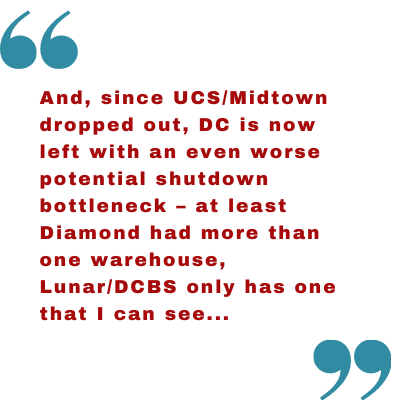
And, since UCS/Midtown dropped out, DC is now left with an even worse potential shutdown bottleneck – at least Diamond had more than one warehouse, Lunar/DCBS only has one that I can see, and Indiana is looking to me as not doing great with COVID.
Let’s put that aside, though, and return to the mechanics of publishing, of which DC Comics is at least a $226 million dollar annual business: $162.8 million in Direct Market Sales, $33.4 million in bookstore sales, and something well south of $30m in digital. There’s a ton of sales that aren’t reflected in those numbers, of course: while it will include the TPs and GNs sold through Walmart, et al (because they report to BookScan), it doesn’t appear to include any of the periodical comics sold there, nor will it have the bulk of educational sales, since those sales aren’t being sourced through retailers (generally speaking). It’s also really unlikely to consider any sales through direct-to-consumer sources like, off the top of my head, Scholastic Book Fairs run at schools. It won’t have any “custom publishing” in – like where they make a deal with, dunno, Snickers or something, to make promotional comics. [Editors note: these numbers also do not include sales to libraries, which are way down in COVID times.] There’s a few smaller buckets here and there it is missing as well, but overall, I would suggest that money from publishing alone might around $300 million annually? Again: the vast bulk of that comes from the Direct Market.
However, this is a “rounding error” for Warner Bros, when a single film like “The Joker” grossed well over a billion dollars.
I honestly don’t know what licensing brings in (Batman on t-shirts or Wonder Woman Underoos or whatever), though I would generally expect it’s a reasonable multiple of publishing itself, maybe triple-ish? – nor do I know how such revenues are booked today, whether against DC’s books or Warner Bros – but back in the day at least, based on conversations with ex-executives, publishing had to be self-sufficient in and of itself.
On the other hand, AT&T, the parent company of DC and WB, is carrying almost $169 billion (with a “B”!) in debt
DC is currently run by Pam Lifford, whose title is “President of Global Brands and Experiences”. This title should give a reasonable clue as to how Ms. Lifford thinks of DC: as a “brand and experiences”, rather than as a publisher. The things one does to manage a “brand and experiences” are pretty utterly foreign to what one needs to do to successfully be a publisher of content, and a lot of the expressed thinking appears to be based on logics that sound great in business school, but don’t actually match the on-ground reality of how and why people buy books and comics.
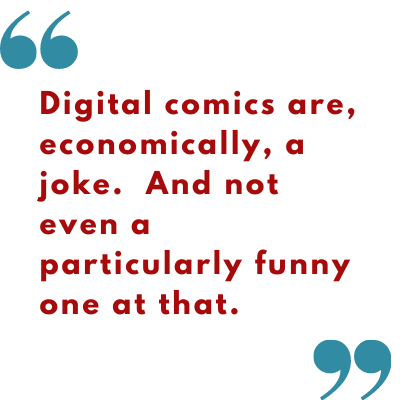
This here is where I need to make an observation that I am shocked I have to: Markets and market forces follow logical and traceable patterns, and just wanting a thing to happen usually won’t make it happen without absurdly hard work. Or, perhaps, to phrase it a more poetic way:
Gravity is a Law, not merely a Friendly Suggestion
Let’s go through those bullet-pointed markets one at a time to make sure you understand the counter-factuals here, and let’s start with “Digital”.
Digital comics are, economically, a joke. And not even a particularly funny one at that. For well more than ten years virtually every publisher has really really really tried to make digital a “thing”, but every piece of evidence says that while you can get people to look at digital comics, you simply can not get a meaningful number of people who are interested in paying for them in a regular and dependable fashion. Comichron and ICv2 peg digital comics, all digital comics from all publishers, at roughly $90 million in annual sales – and that number hasn’t changed meaningfully whatsoever in multiple years of tracking.
I’ve yet to find any comic book publisher who says that digital sales alone are enough to keep new content being produced, and even the books that are touted as great successes in digital (DC’s “Injustice” might be one) became financially viable only after the print numbers are added in.

I also firmly and emphatically believe that while comics may be, as Scott McCloud put it “juxtaposed pictorial and other images in deliberate sequence, intended to convey information and/or to produce an aesthetic response in the viewer”, that the actual thing that makes comics what they are is not, in fact, the individual panels/images that make up the comic, but the gutters between the panels instead, because that’s where the audience lives and interacts. The informational content of a PAGE of comics is as important, if not more so, than the individual PANELS contained within, so that when you’re not receiving the entire page as a whole (which is nearly impossible on a phone-size interface), you’re not actually receiving comics as such.
Obviously, there is a contingent of folks who will disagree – folks who have edge case issues (say vision issues, or storage space issues, or even just “I had enough money to sink into this to buy that 20-inch screen just to read comics” folks), but the numbers say they’re in the vast minority of people – and a number that, most importantly, is not large enough to support the creation of material all on their own in a way that pays any creator for their time.
I’ll add one more wrinkle on digital, one that mostly applies to DC and Marvel, and it is that I have come to the conclusion over the years that people don’t like “superheroes” in and of and for themselves alone – rather, what people truly enjoy about the Marvel and DC universes is the soap opera nature of it. They like that Spider-Man and Iron Man and Captain America all “live in the same world”, and they like the continuity that can be built up between those individual stories to create a greater whole than the individual parts. And one of the ways people ascertain the value they receive from these stories, is that the stories “count”, that the continuity matters and adds up to something. And that’s one of the major reasons that what we’d call the “mainstream of continuity” in comics sells really terribly for Marvel and DC while it’s the “off brand” material (like, say, “Injustice”) that tends to do much better in digital formats. That is to say, unless it is released in a physical form as its primary release, it isn’t “true”. And while that works just fine for “non-continuity” stories like “Injustice”, if a Batman comic isn’t released first into the physical collector’s market, it simply doesn’t “count” and will only sell a tiny fraction to the hardcore base that is buying the majority of periodicals released.
All of these things together show why, as a general rule, digital comics tend to sell single-digit percentages of what their print counterparts can do. And why any kind of “digital first” strategy is almost certainly doomed to fail before it even gets out of the gate: only a subset of the subset of the subset of people who read comics (or read for pleasure at all!) are going to buy into the format whatsoever.
But what about the book market? You’ve read many headlines stating that book sales are climbing, and the book stores are posed to be a bigger and bigger and bigger slice of the pie, etc, right? I’ve literally been advancing the importance of book format material and “GNs in the bookstore” longer than the average career of a DC executive these days, and I’ve written the annual survey of BookScan for almost two decades now, and please take my word when I say that bookstores and graphic novels are an incredibly important market, but that the math isn’t saying what the headlines seem to imply.
First and foremost, the single-stream revenue from an “original graphic novel” (non serialized) can be enormous (especially if you are a Raina Telgemeier or Dav Pilkey), but that the overwhelming majority of such books are unlikely to earn their creators any more income then their advance. I’m not even thoroughly convinced that most OGN makers are even earning back their advance in the first place. And, most importantly, without page rates like “traditional” comics publishers pay, there’s a super-great chance that your average GN maker is making less than minimum wage to make that book.
One of the most fantastic things that periodical comics do is that they amortize costs and generate multiple revenue streams in order to perpetuate themselves. To give you the clearest version of this that I can, let’s take “the most popular” DC superhero, Batman, and look at 2019 BookScan sales. There were forty different books released in 2019 with “Batman” as the first word in the title in BookScan figures this year. The single best-seller was “Batman: Damned” which sold all of 14,156 copies into the book market. The second best seller was the ninth volume of Tom King’s run, which sold, ugh, 3,426 copies. The average sale for these forty selections is all of 1220 copies. And this is their most popular character.
Conversely ICv2 says “Batman: Damned” #2 sold 144k copies into the Direct Market. Tom King’s run on the monthly averaged north of 100k each.
Almost certainly, “Batman: Damned” would not be profitable solely as an OGN released to the bookstores. Tom King’s run would have been a steadfast money loser. And, again, this is the most popular character, with some of their most popular creators.
“But But!” someone is starting to yell, “I Heard that ‘Raven’ OGN did amazing in the bookstores!” – and, sure thing, it sold nearly 43k copies, which for sure made money… but the next best-selling Zoom or Ink book sold a bare 8200 copies, and the one after that? Below 5k. In fact, taking it as an average, the average Zoom or Ink OGN sold 4622 copies, and is you don’t include “Raven” in there, that number drops to a likely unprofitable 2700 copies.
A thing I have learned in decades of watching the bookstore numbers: That market isn’t looking to buy forty different “Batman” books each year – they don’t even want forty “superhero” books each year. They want maybe five or six at the most. But in order to be a publisher, you pretty much must produce forty in order to pay your staff, your rent, your overhead.
The sad and hard truth about publishing is that most books (include prose in this too!) never make any money whatsoever – it’s a handful of titles at the top of the frontlist that generate the majority of your overhead, and everything else, you’re just hoping to not lose too much.
This is the actual and genuine wonder of the Direct Market: a functioning market for periodicals and serialization that pays its own way, lets creators make an actual living from production of work, and supports an international network of independent stores at the same time! There’s no other market like this in America, and, to the best of my ability to ascertain, both DC and Marvel are entirely profitable in this pursuit just from the production of periodicals themselves – the books are gravy.
This market is extremely unlikely to ever be “replaced” by digital, because it is the nature of the weekly release schedule and the nature of the comics store as “dedicated product showcase” that is driving the sales more than the content itself.
Giving that dedicated market up for the no-evidence, no-success premise that you can replace it somehow with a thing built in entirely different ways seems like a real “Underpants Gnome” thinking. Step one: steal the underpants, step two: ???, step three: Profit! just doesn’t work, because for Pete’s sake, Gravity Is A Law, Not Merely a Friendly Suggestion!
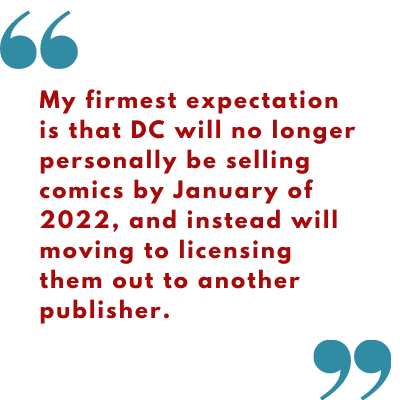
Look, I’m the first to tell you the DM has problems (It’s called “Tilting at Windmills” for a reason, folks!), but it’s crystal clear that when you treat the participants in this market properly (by not, say, dramatically overproducing) and produce good content, the DM is a profitable machine that allows you to amortize your costs and easily reach out to and build wider markets. The DM is not really sexy, and actually it’s kind of janky in places, but the math appears to say that throwing out your single-best sales channel is totally crazy pants, at best.
I can’t see any path that doesn’t cripple DC with these changes to distribution and staffing for the DM – sales are absolutely off on the “bread and butter” of DC’s line in a way that is largely disguised by “Joker War,” “Death Metal” and “Three Jokers” all hitting at the exact same time – and I am 100% certain that these hits were substantially smaller hits than they could have been had DC not tried to force retailers to buy from their largest competitors. But those hits were long-gestating, and are unlikely to be repeated into 2021 based upon what we know of DC’s plans. The first launch of ’21, “Future State”, appears from the outside to be pure commercial death, and DC seems to be suggesting that they’re consciously moving away from continuity this year – the thing that’s actually the “secret sauce” that keeps their production ticking along.
Much like Heroes World and Marvel in 1995, it’s nearly impossible to see how this plan could tick along for more than two years or so, and the hollowing out of staff and services at DC would seem to me to guarantee that DC will be nothing but weaker at the end of this inning. My firmest expectation is that DC will no longer personally be selling comics by January of 2022, and instead will move to licensing them out to another publisher. I suppose it’s conceptually possible they could maybe generate the same profit by going that route, but the math looks poor from my side of the table – instead I will project that thousands of people’s livelihoods and passions will be crushed because people with no desire to figure out how publishing actually works will build pipe-dream scenarios which are going to come crashing down around them.
Because at the end of the day, Marie Javins could be the single best Editor-in-Chief in DC history, but if you don’t have a sales and marketing team there to support you in your single largest market, it’s like asking someone to drive in the Indianapolis 500 without having a pit crew.
I sincerely hope that the other market participants, my fellow retailers, and Diamond itself, are making strong plans for a future without DC Comics. I can’t see how any other result is likely.
**************************
Brian Hibbs has owned and operated Comix Experience in San Francisco since 1989, was a founding member of the Board of Directors of ComicsPRO, has sat on the Board of the Comic Book Legal Defense Fund, and has been an Eisner Award judge. Feel free to e-mail him with any comments. You can purchase two collections of the first Tilting at Windmills (originally serialized in Comics Retailer magazine) published by IDW Publishing, as well as find an archive of pre-CBR installments right here. Brian is also available to consult for your publishing or retailing program.


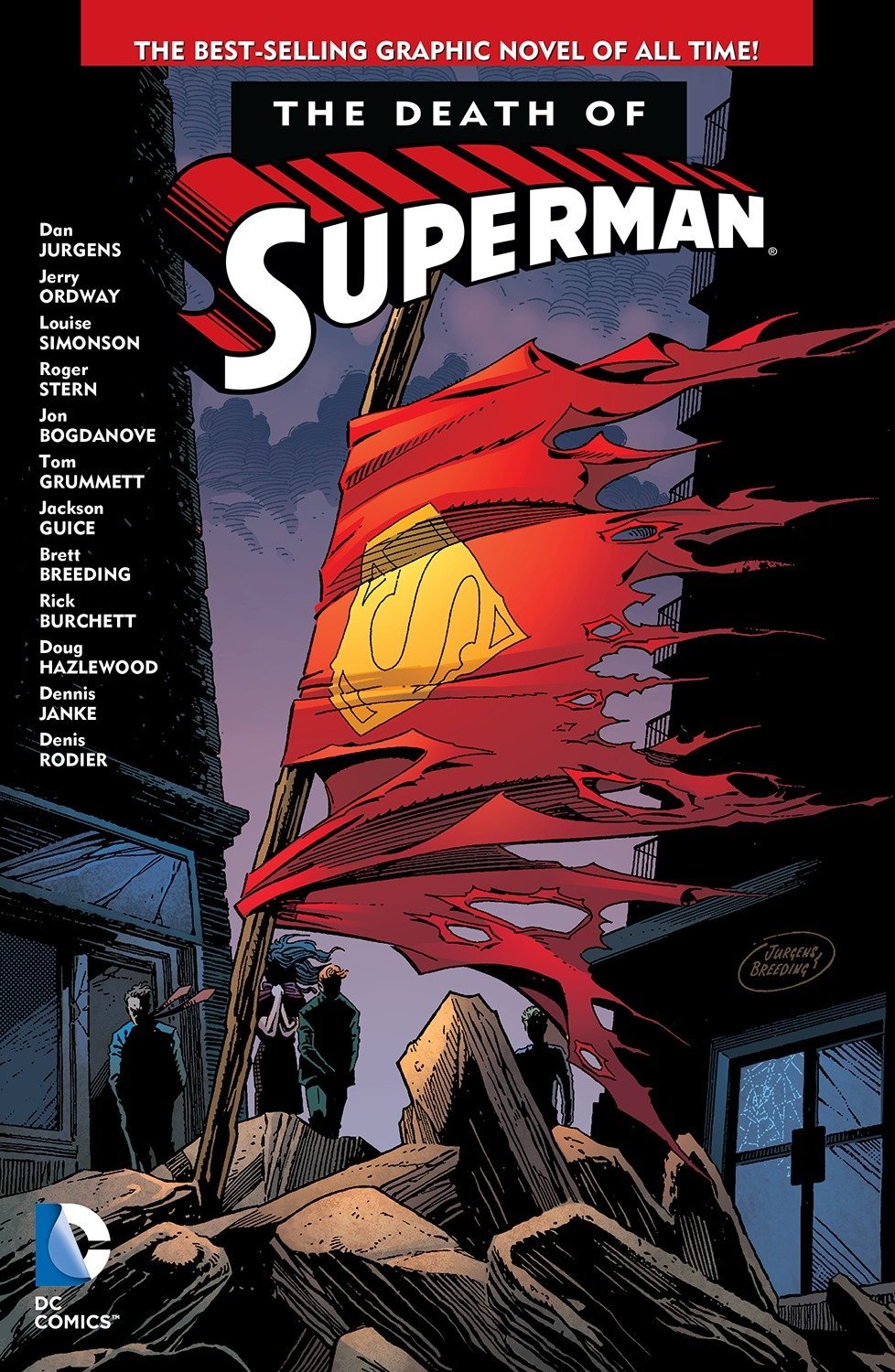
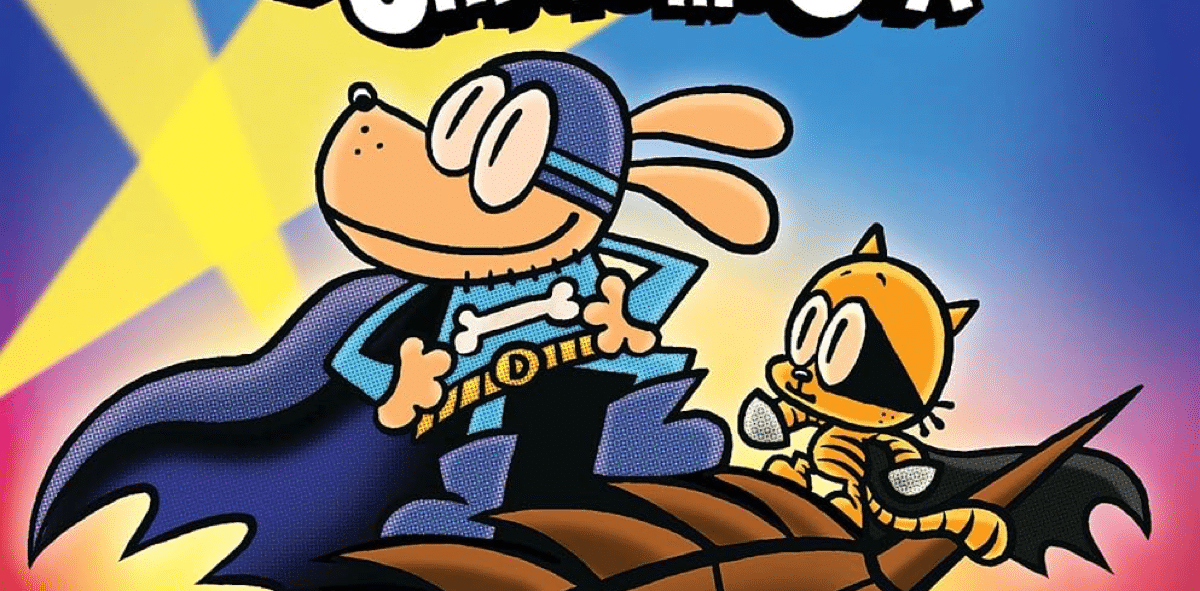
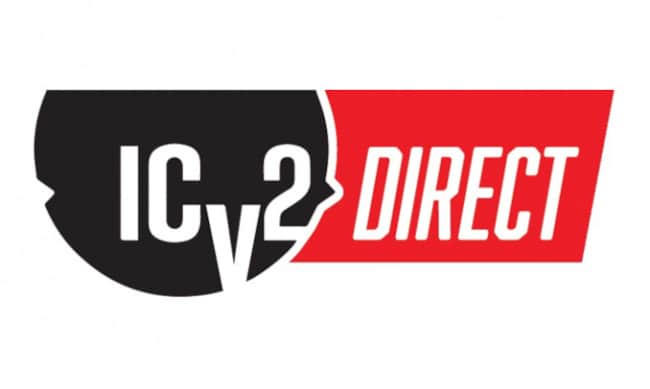
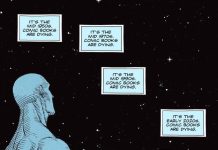



I think Warner-AT&T only cares about the value of preexisting IP (i.e., characters that are owned by corporations, not by the people who created them). These characters are much more lucrative in movies, TV shows, streaming and videogames — not to mention merchandising — than in comic books.
Like Brian, I expect DC to be out of the monthly periodical business by the end of 2021. And I expect Marvel to follow their lead, maybe with prodding from Disney.
Silent movies died. So did pulp magazines and radio drama. Now it may be time for the comics pamphlet to bite the dust. This will upset retailers, who are mostly aging fans with a lot of nostalgia for floppies. But asking people to pay $4 for a thin magazine that can be read in 5 minutes is ridiculous. Only the most hard-core fans are still buying them. And that group is getting smaller and older every year.
I agree with that first paragraph, George, although I will quibble and say that I expect much of the strength of the characters come from them being “active and vital”, and in their native medium. I can’t say for certain, but I think the licensing value of these characters will drop significantly if their corporate masters abandon comics. Not a thing I can prove, but perhaps time will tell.
Your last paragraph genuinely confuses me, however. By what external metrics are you making assertions like “Only the most hard-core fans are still buying them. And that group is getting smaller and older every year”? I see no empirical evidence that any such thing is true whatsoever, and my own anecdotal evidence of who is buying periodical comics in my two stores stay exactly the opposite: we’ve got, and have had for the last half-decade or more, a steady influx of new readers in their 20s newly-buying-periodicals and loving them. They’re just not buying in to superhero comics, largely, I think because DC and Marvel have let it get broken because they made a corporate decision, consciously, to prefer selling one person two copies over trying to attract a different new reader.
Direct Market retailers like periodicals not because we are “mostly aging fans with a lot of nostalgia”, but rather because we know how to do math and can see that the number of actual humans who will buy into a comic story when it is serialized is virtually always multiples of those who will buy a book-only format, and that the ongoing revenue from that serialization not only amortizes the cost of production for the publishers, but also pays ongoing costs like rent and wages for the stores, and allows things like “page rates” to be paid to creator people, which allows them to have a chance to earn an actual living from comics — MOST “original graphic novels” are unlikely to earn back their advances, which are usually not even minimum-wage level pays for most, given the time of production involved. And this is only magnified, many-fold, when discussing shared-universe stories.
-B
As usual, retailers think everything is great, sales are great, readership is growing, but DC is destroying the direct market for no reason at all. Retailers cling to the past and to the status quo. They can’t imagine comics surviving without comic shops.
The demise of the direct market might kill off the monthly superhero periodical (the bread and butter of comic shops), but comics will survive.
Brian,
First, I’m EXTREMELY happy to hear you’re in better health. Praise to whomever did that.
Second, as always, I’m so glad the DM has you in it to analyze it’s state.
Thank you for being you.
Matt Dow
Can someone explain to me was Series Code data is? That’s not something I’ve heard before.
“Retailers cling to the past and to the status quo.”
Ok. Do you have anything to refute the points he made?
Sober analysis Brian, except I feel for the part about distribution. Diamond is terrible and needs to go; don’t forget Diamond also announced that they weren’t going to be able to pay their own bills around the time they shut down.
You complain about DC forgetting about history, but you’re forgetting that every comic distributor was also a former store that at some point made the leap to distributor. By “promoting” two stores, DC wasn’t playing favorites (other than maybe Lonestar, what better shop to partner with than the two they picked?) and was paying attention to history.
Most of these comments are incredibly defensive. Fans are circling the wagons to protect two dying industries — the direct market and the Marvel-DC superhero pamphlet.
At the comic shops in my town, I don’t see young people buying Marvel and DC pamphlets. The people buying them are the iconic fat, bald, bearded, bespectacled middle-aged comic book guys. (The John Byrne look of the ’80s lives on!) The young customers are buying everything except the Big Two’s floppies.
Patrick, a series code is a standardized code issued by Diamond that allows retailer systems to associate multiple products with a particular ongoing title. If you just went by the order codes — SEP202371, for example — you wouldn’t know what title it connects to; the series code provides that
Joseph, Diamond’s situation this spring appears to have been common to many businesses where cash flow is constant: when there’s been 80 years of new releases every single week, it’s logical not to assume you need to keep a lot in cash because there’ll be a month with no comics whatsoever. Obviously they tapped their credit, as things are rolling again.
Okay, so Series code comes from Diamond’s Previews data set as far as I can tell. Unless it’s provided elsewhere, I’m not seeing it when I sign into Diamond’s retailer portal. Their FOC data doesn’t have it. Their Invoice data doesn’t have it. When I look up a specific item, other data is provided but not series data.
However, I wouldn’t call it standardized in the sense that other systems use it. Lunar and USC would have to get their values from Diamond since Diamond is the only provider for this data, so it doesn’t really make sense for them to provide their own. (I wouldn’t claim Diamond’s databases are standardized in their own data structures either, but that’s the IT person nitpicking and beside the point.)
Luckily barcodes are standardized (UPC is provided by Lunar BTW). They’re right there on the cover, and they do contain series data (including series number, issue number, additional printing, and variant cover data). I guess I was wrong in assuming other retailers knew how to read them.
Chris, Series Code data is part of the “backend” data set that DIamond includes as part of the “Master Data File”. If you go to the retailer website, hit the sidebar for Downloads -> Date Files, then scroll down to “PREVIEWS Master Data Files”, you can find all of that data, month-by-month. Download “PREVIEWS Master Data File Key Guide” to give you info about what each of those fields are.
To the best of my knowledge (which is slightly less than perfect because I don’t USE other systems), every major Point-of-Sale system used in the comics industry (MOBY, ComicsHub, Comics Suite) uses this as the backbone for managing pulls — but it’s, uh, sub-rosa I guess, happening “under the hood”
I didn’t think that barcodes are actually “100%” consistently consistent, at least that was the conversation I had with a developer 10+ years ago when I last needed to learn this stuff — numbers are not assigned from a common database that I understand, rather they look internal to each publisher (I’d love to be corrected on that) and, more importantly, several companies/publications REUSE THEM regularly (to stay on topic of column: DC’s MAD MAGAZINE reuses the same few barcodes year after year, which cause us real problems; HEAVY METAL does the same)
Additionally, having a field that is different than barcode means one can build different relationships in a DB than the publisher does. For example, because of the +5 ean data, publishers have to give “annuals” a different sequence number than the main book. I can’t “override” a barcode, but I can sure as shooting do it to the backstage series code, and do it all of the time.
Additionally, series of books (picture the 9+ volumes of Tom King’s BATMAN) use the +5 not for Issue/sequence/printing, but for PRICE, which means a barcode-driven system can’t manage subscriptions for series of books (nor do BOOK isbns appear to share that common data format anyway, like comics periodicals do)
-B
George, it is REALLY GLARINGLY obvious that you have ABSOLUTELY NO IDEA what you’re talking about. Please be quiet and let individuals with knowledge add to the conversation without you diluting it with your nonsensical “logic”
Currently working at one of the largest shops in the world and there’s probably 20 people in here and none of them are over 40, so you really have no idea what you’re talking about, your local shops is not a barometer for the entire world.
I don’t know how a company in so much debt was allowed to purchase another company… only in America.
But I would personally love it if there were way fewer books released every month so more people could keep up.
I simply stopped reading most Marvel because there were too many X-Men titles every week and I couldn’t keep up. I’ve dropped some DC stuff for the same reason. I imagine they’re losing a lot of money from customer fatigue… and making books with characters no one really cares about… Did we really need a Taskmaster solo series? Did we need an Aero? Sword Master? At least with DC they try and throw Batman into every team so at least there’s initial interest.
I think a lot of money could be made up by just making smarter decisions with what titles to publish and how frequent to publish. I don’t think anyone really cares if their books come out once a month or once a week. I just want them to be good.
Didn’t DC end some series digitally this year? Be interesting to see the breakdowns on those numbers. This is what is the question in my mind: once DC and Marvel go digital-only on most of their series, who will follow to digital? How many will make the journey over to the subscription utopia, i mean, internet and how many will close their “head canon” and focus on back issues and collected editions.
Will DC fail to print collected editions of their older material over and over and over and over and over again with new trade dress that they sell out of Amazon? Why would they ever stop that? Why wouldn’t DC do a collected edition of the digital-only Batman series, if it comes to that, for people who like the smell of things: like books? Can the direct market run off of Image and the indie folks along with DC and Marvel’s backcatalog as well as the occasional collected edition of whatever is online?
I feel bad for Brian Hibbs and all small business owners now. Glad to hear of Mr. Hibbs good health! We, most of us, appear to be bit players in giant games. Good luck in 2021 everyone who read this.
“All was well, until one day they met a thunderstorm—more than a thunderstorm, a thunder-battle. You know how terrific a really big thunderstorm can be down in the land and in a river-valley; especially at times when two great thunderstorms meet and clash. More terrible still are thunder and lightning in the mountains at night, when storms come up from East and West and make war. The lightning splinters on the peaks, and rocks shiver, and great crashes split the air and go rolling in tumbling into every cave and hollow; and darkness is filled with overwhelming noise and sudden light. Bilbo … saw that across the valley the stone-giants were out, and were hurling rocks at one another for a game, and catching them, and tossing them down into the darkness where they smashed among the trees far below, or splintered into little bits with a bang … they could hear the giants guffawing and shouting all over the mountainsides.”
—Tolkien, The Hobbit, Chapter IV: “Over Hill and Under Hill”
The truth is probably somewhere in the middle. Young people by and large aren’t interested in comics (there is a percentage, but they probably pirate anyway). The whole ‘old comic guy’ is kind of overblown. Gen Z is probably more interested in manga. And why should they? The value proposition in terms of stories and price is terrible.
At some point, DC is likely to be, at best, a far less money maker for debt heavy AT&T. Personally, my guess is they can’t sell the publishing operation (and if they did, they’d hold on to the IP so who’d buy and for how little). Therefore, if you can’t sell it, and licensing to another publisher would have limited upside, likeliest will be shutting it down.
Then again, $4 pamphlets had their own expiration dates.
(As for Marvel, a) Disney doesn’t have AT&T’s debt problem — not even close — and b) Marvel’s IP has made Disney enough money that they can tolerate Marvel’s wee publishing operation.)
And while I’m at it: Brian notes the gross $$ the LCS are giving DC but I’m curious what the average gross per store is. If the LCS are the one true hope for publishers, how viable is that pipeline for the long term?
So. Is this the DC Implosion II or just a shit show?
Thanks for the great insights, Brian. They truly are illuminating. And I am glad to hear that your health has improved. I do have some comments and questions.
Regarding the readership of digital comics, one of the stunned me while watching the Ringo Awards this year was just high high the readership of web comics is. Each of the winners had MILLIONS of readers. I have not heard of numbers like that in quite some time. A subtle point you make is that they re not paying readers.
For myself, I mainly get my comics during the weekly trip to the comic book store. But during COVID, I have started reading digital comics for the first time. (Injustice, was in fact my first purchase.) I do prefer to read print but I like some of the advantages of digital. Namely, I don’t have to worry about storage. I find it is a great way to try new series without having to keep them around. I’ve also used it to pick up and read older material. Finally, I have on occasion used it to read issues that have sold out at my local store. Going forward, I am not sure how I will balance print and digital. I’ve been shopping at the same store for almost 25 years, and I do want to support them. Regarding Injustice, I thought that it had been doing well in print. Is that not the case? Are most of its sales digital.
Regarding the future of DC publishing, you did not talk about their General Manager Daniel Cherry at all. Doesn’t his appointment signify a commitment to keeping the publishing alive?
@jim: “Regarding the future of DC publishing, you did not talk about their General Manager Daniel Cherry at all. Doesn’t his appointment signify a commitment to keeping the publishing alive?”
—How does appointing someone with no publishing experience “signify a commitment to keep publishing alive?”
@ manqueman: “Therefore, if you can’t sell it, and licensing to another publisher would have limited upside”
—LIMITED UPSIDE. Oh my dear, you don’t know much about licensing fees do you?? Pam Lifford does.
@Joseph: “DC wasn’t playing favorites (other than maybe Lonestar, what better shop to partner with than the two they picked?) and was paying attention to history.”
—PAYING ATTENTION TO HISTORY. Yeah, it’s a big group of comic business history scholars over there in Burbank right now, especially after gutting most of the long term staff. How do you people write such nonsense?
@tim: “Will DC fail to print collected editions of their older material over and over and over and over and over again with new trade dress that they sell out of Amazon? Why would they ever stop that?”
—You’re not paying attention. They’ve gutted the staff, the folks who actually sell the stuff. They’ve gutted the periodic line, the source of all those collections. BACKLIST DOESN’T SELL FOREVER. Perhaps you should focus a little more on facts and a little less on Tolkien in your business analysis, mkay?
@eggbert: “—How does appointing someone with no publishing experience ‘signify a commitment to keep publishing alive?'”
Good point. But by appointing a fast rising star with drive and ambition and who recognizes the importance of building a community, it does signify a desire more than strip mining the characters. So I think it does signify a commitment to keeping the characters dynamic and fresh and to maintain and build a community around them, somehow. It might not be publishing, but I expect comics of some form.
Cody Walker: You need to leave your bubble and interact with human beings every now and then. YOUR shop is not a barometer for the world, either.
But as a comic shop employee (with zero social skills, like most comic book guys), you see your world through rose-colored glasses.
Stores that sell to dense metropolitan audiences almost always usually are selling many multiples of their peers in less metropolitan areas. I don’t specifically know Cory, or where he works (and my guess is he’s not “spokesman” for that organization), but, seriously “George”, eat my balls for the gratuitous insults.
-B
BIPAD (magazine barcodes) explained:
http://bipad.com/
Comics publishers use the plus-five number thus:
xxxyy where xxx equals the issue number and yy is reserved for the various editions of that issue.
Other magazine publishers use that field for a date or week number, since the issues are not sequential or worth collecting.
@jimp:
“by appointing a fast rising star with drive and ambition and who recognizes the importance of building a community”
—Objection. Assumes facts not in evidence. And who regurgitates press releases like that anyway, eh “Jim”?
“…but I expect comics of some form”
—Jesus Christ. Game over.
Jesus, it’s just a job. Old guy cost too much, new guy will do it for half the salary. DC will sputter on until one day some higher up exec decides it not worth it and then kaput. Companies always say they’re in it for the long haul.
@eggbert
“Objection. Assumes facts not in evidence. ”
The two sources that inspired bu comments are this Beat article https://www.comicsbeat.com/activision-blizzards-daniel-cherry-hired-as-general-manager-of-dc-comics/ and the Forbes article it references https://www.forbes.com/sites/brucerogers/2019/07/24/cmo-daniel-cherry-iii-leading-activision-blizzard-into-esports-future/#2e0d36793ae6 .
It had been several months since I’ve read either one, so clearly I recalled some details incorrectly. For one, Daniel Cherry was an external hire, not an internal one. But doesn’t that bolster my point that they are investing the company, not stripping it bare?
Regardless, you may disagree with my conclusions but there is evidence supporting them
“‘…but I expect comics of some form’ —Jesus Christ. Game over.”
My apologizes, that sentence was very poorly worded and did not convey at all what I was thinking. Namely, that Time Warner plans on keeping these characters alive through not only the publishing of comics (which I would not be surprised at all if that gets outsourced), but also digital comics (which Brian talked about in great detail), video games and animation. While the later two are much different mediums than comics, I feel they are kindred spirits and more closely related than live action movies or television.
Whether a plan like that is good or bad, I cannot hazard an opinion.
@jim
You are quoting press releases to back up your claims about someone you know nothing about. What is wrong with you?
This fan desire to mindlessly defend rapacious multinationals simply because of the particular IP they control is just creepy.
@eggbert I was going to respond to you remarks, but thought better of it. You’re too emotionally involved in order to have a meaningful conversation.
I am concerned about the future of the industry, which is undergoing drastic changes. A lot of people have lost their jobs and their livelihoods; that is a terrible thing. And things would worsen considerably if DC stopped publishing comics.
@jim Nice try. You’re the one who is “emotionally involved” here, with your witless defense of corporate politicians. Then you 180 here and claim the sky is falling. Go away.
What I was trying to do was get back to the topic I was interested in discussing. But you declined. It was worth a shot.
Brian Hibbs said: “seriously “George”, eat my balls for the gratuitous insults.”
Brian, gulp down some more junk food and have another heart attack.
Alright, we’re done here.
Comments are closed.